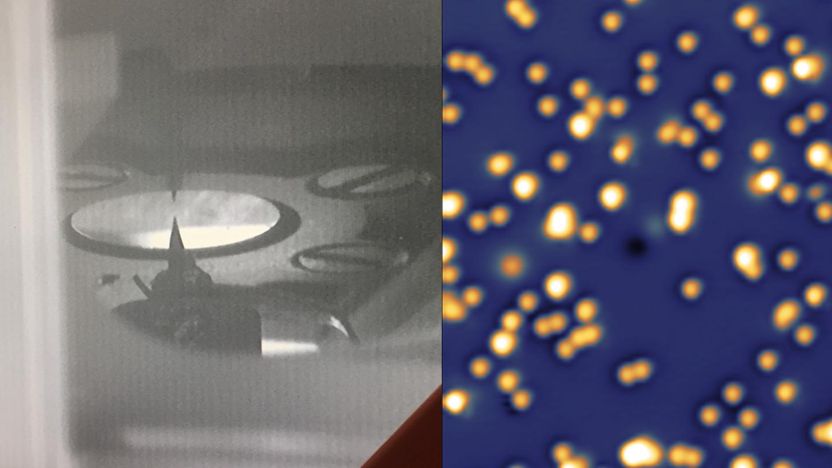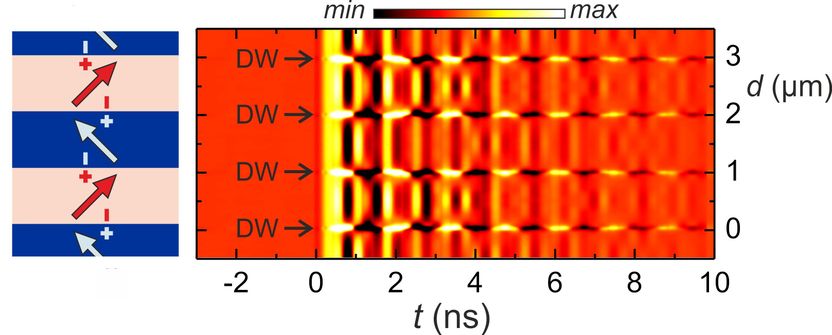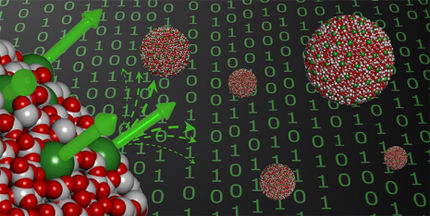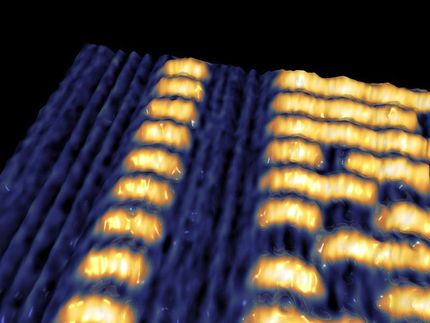A step closer to single-atom data storage
Despite the rise of solid-state drives, magnetic storage devices such as conventional hard drives and magnetic tapes are still very common. But as our data-storage needs are increasing at a rate of almost 15 million gigabytes per day, scientists are turning to alternative storage devices.

LEFT: STM image of Holmium single atom magnets. RIGHT: and Cobalt helper atoms on magnesium oxide.
F. Natterer/EPFL
One of these are single-atom magnets: storage devices consisting of individual atoms stuck ("adsorbed") on a surface, each atom able to store a single bit of data that can be written and read using quantum mechanics. And because atoms are tiny enough to be packed together densely, single-atom storage devices promise enormous data capacities.
But although they are no longer science fiction, single-atom magnets are still in basic research, with many fundamental obstacles to be overcome before they can be implemented into commercial devices. EPFL has been at the forefront of the field, overcoming the issue of magnetic remanence, and showing that single-atom magnets can be used to read and write data.
In a new study physicists at EPFL's Institute of Physics have used Scanning Tunneling Microscopy to demonstrate the stability of a magnet consisting of a single atom of holmium, an element they have been working with for years.
"Single-atom magnets offer an interesting perspective because quantum mechanics may offer shortcuts across their stability barriers that we could exploit in the future," says EPFL's Fabian Natterer who is the paper's first author. "This would be the last piece of the puzzle to atomic data recording."
The scientists exposed the atom to extreme conditions that normally de-magnetize single-atom magnets, such as temperature and high magnetic fields, all of which would pose risks to future storage devices.
Using a Scanning Tunneling Microscope, which can "see" atoms on surfaces, the scientists found that the holmium atoms could retain their magnetization in a magnetic field exceeding 8 Tesla, which is around the strength of magnets used in the Large Hadron Collider. The authors describe this as "record-breaking coercivity", a term that describes the ability of a magnet to withstand an external magnetic field without becoming demagnetized.
Next, they turned up the heat: The researchers exposed a series of Holmium single-atom magnets to temperatures of up to 45 Kelvin, (-233.15 degrees Celsius), which, for single atoms, is like being in a sauna. The Holmium single-atom magnets remained stable up to a temperature of 35K. Only at around 45K, the magnets began to spontaneously align themselves to the applied magnetic field. This showed that they can withstand relatively high temperature perturbations and might point to the way forward for running single-atom magnets at more commercially viable temperatures.
"Research in the miniaturization of magnetic bits has focused heavily on magnetic bistability," says Natterer. "We have demonstrated that the smallest bits can indeed be extremely stable, but next we need to learn how to write information to those bits more effectively to overcome the magnetic 'trilemma' of magnetic recording: stability, writability, and signal-to-noise ratio."
Original publication
Other news from the department science

Get the chemical industry in your inbox
By submitting this form you agree that LUMITOS AG will send you the newsletter(s) selected above by email. Your data will not be passed on to third parties. Your data will be stored and processed in accordance with our data protection regulations. LUMITOS may contact you by email for the purpose of advertising or market and opinion surveys. You can revoke your consent at any time without giving reasons to LUMITOS AG, Ernst-Augustin-Str. 2, 12489 Berlin, Germany or by e-mail at revoke@lumitos.com with effect for the future. In addition, each email contains a link to unsubscribe from the corresponding newsletter.
Most read news
More news from our other portals
Last viewed contents
Silverite
Beta_adrenergic_receptor_kinase-2
Silver_chloride

Study calculates the speed of ice formation
Extremely_low_frequency
Copper(I)_oxide
Metal
Category:Meglitinides

Bubble-recoil could be used to cool microchips, even in space
Electron pairs precede high-temperature superconductivity - New method exploring 'energy gap' shows electron pairs exist before superconductivity sets in





























































